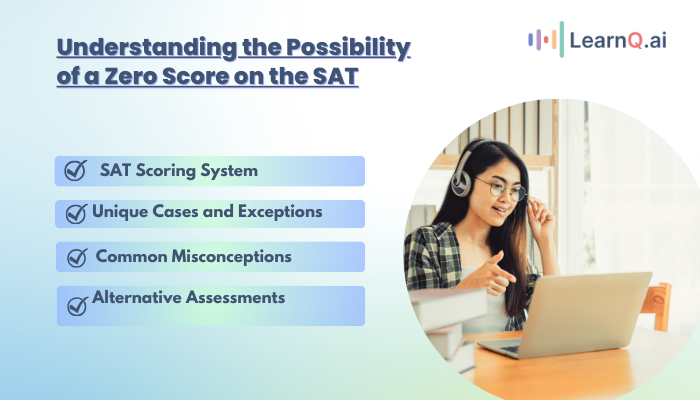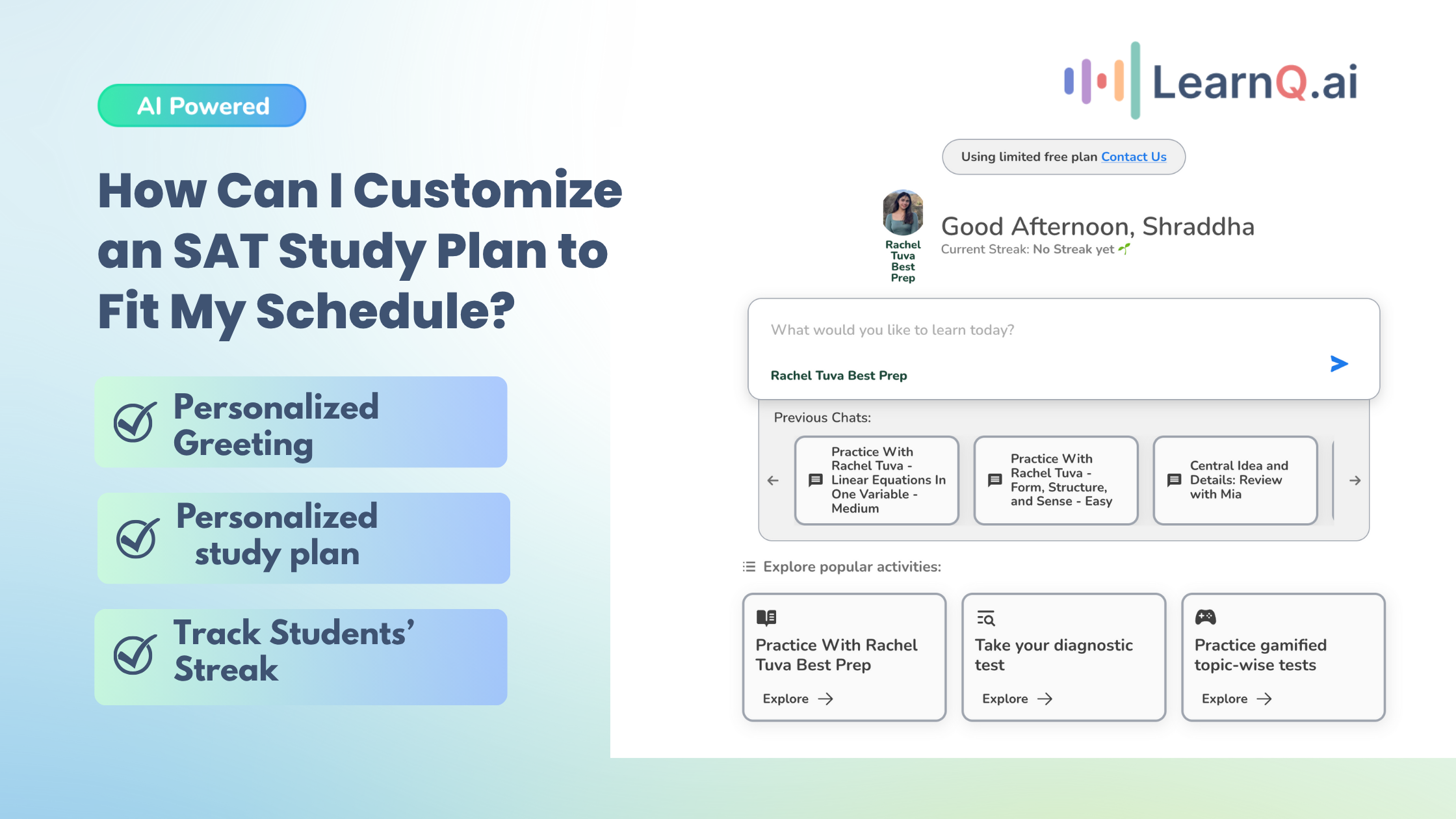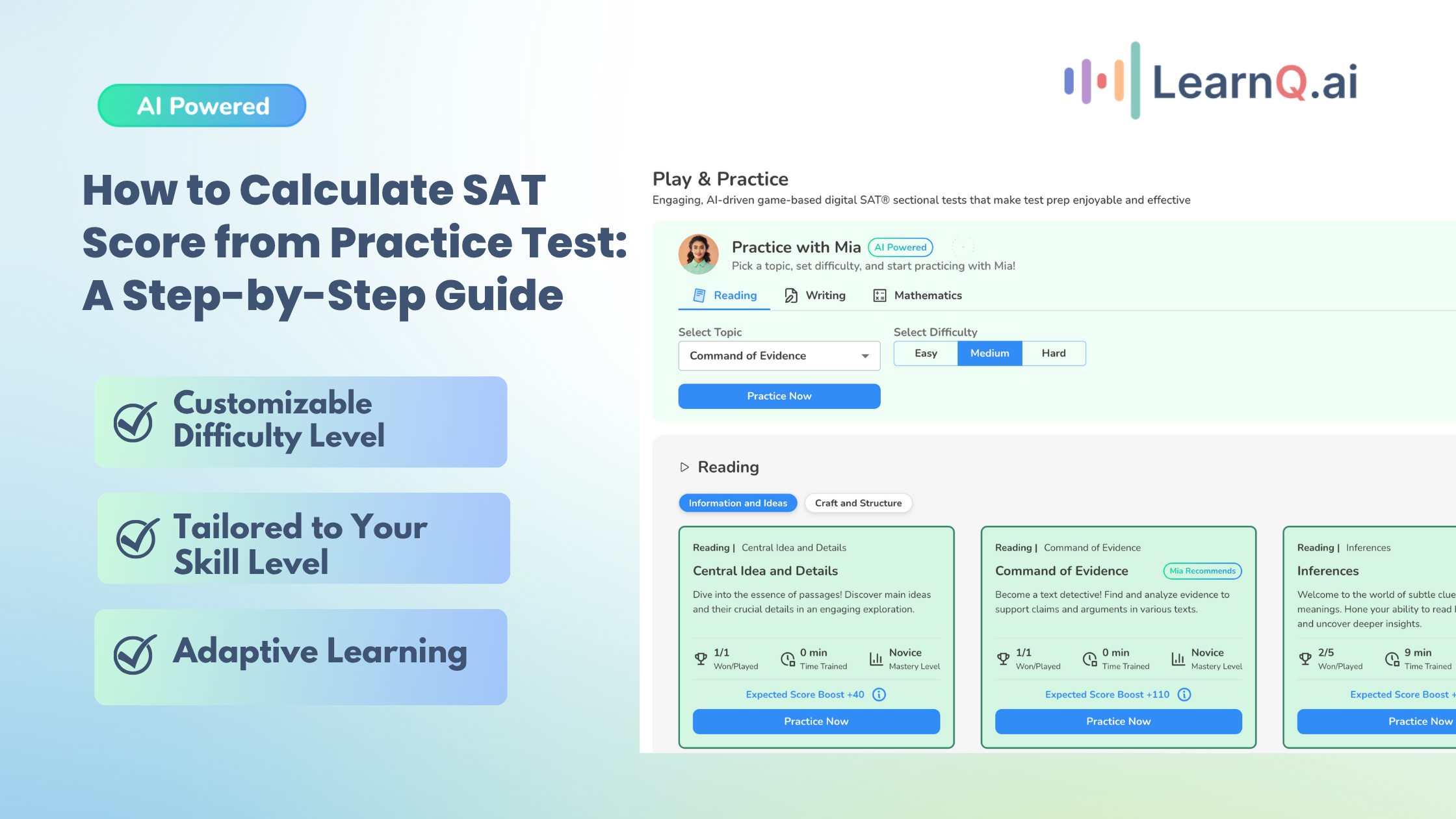If you’ve ever stressed about bombing the SAT, you might wonder, “Is it possible to score a 0?” The answer may surprise you.
Unlike some tests with straightforward pass-or-fail scores, the SAT uses a scoring system that actually makes a true zero impossible.
But that doesn’t mean that extremely low scores don’t come with severe consequences, mainly if you aim to get into competitive colleges or schools using SAT scores as a performance metric.
LearnQ.ai is Powered by VEGA AI—Is your Institute Next?
Give students a Duolingo-style test-prep platform with Shopify-level customization for tutors and institutes.
This blog clears up confusion about low SAT scores, covering questions like: Can you score a 0? What are common SAT scoring myths? And how can students avoid low scores?
Whether you’re a student aiming to improve or an educator guiding students, understanding SAT scoring is key to a successful test day.
Let’s get into the facts, bust the myths, and share real tips to help you boost your SAT scores.
Understanding the SAT Scoring System
Let’s keep it straightforward if you want to understand how the SAT is scored or explain it to students as a teacher or an advisor.
The SAT scoring can be tricky initially, but the numbers make sense once you break it down.
How is the SAT Scored?
First off, the SAT score ranges from 400 to 1600. This total score is split between two main sections: Evidence-Based Reading and Writing (EBRW) and Math. Each section scores between 200 and 800, giving you the combined score.
This structure means each section carries equal weight, which is helpful when advising students on where to focus their efforts.
Raw Scores vs. Scaled Scores
Raw scores and scaled scores can be a bit confusing, so here’s a quick look at how each affects your SAT results:
| Score Type | What It Means | How It’s Calculated | Purpose |
| Raw Score | Total number of questions you got right. | Count all your correct answers (e.g., 45 correct answers = raw score of 45). | Reflect on your basic performance on the test. |
| Scaled Score | Adjusted score based on difficulty. | Your raw score is adjusted to account for test difficulty. | Ensures fair comparison across different SAT versions. |
Impact of Wrong Answers
One of the most common questions about the SAT is, “Do wrong answers hurt my score?”
The good news here: the SAT doesn’t penalize wrong answers. Unlike some tests, where wrong answers might pull your score down, the SAT allows students to guess without fear.
That means every question left blank is a missed opportunity for points, but a guessed answer at least has a shot.
This policy has important implications for teachers’ and institutions’ test-taking strategies. Students should be encouraged to answer every question, as a blank answer guarantees zero points, while a guessed answer holds the potential for additional points.
Now that you understand how the SAT is scored, let’s explore whether it’s actually possible to score a 0.
Enhance your Digital SAT study routine with AI-driven insights and personalized practice tests.
Can You Actually Score a 0?
Are you wondering if scoring a flat-out zero on the SAT is possible? Let’s clear that up. The SAT doesn’t actually allow a score of 0.
The scoring system gives a minimum of 400 points, with each section (Reading, Writing, and Math) starting you off with at least 200 points, even if you don’t answer anything correctly. So, scoring a 0 just isn’t possible.
Since the SAT’s design ensures a baseline score, you can leave every question blank and still get 400 points.
This setup prevents total score wipeouts, so no matter what, a “0” score just isn’t in the cards.
Real-Life Reasons You Might End Up with a Very Low Score
While a zero isn’t possible, there are situations where you could still end up with the minimum score:
- Illness or Emergency: If something unexpected happens on test day, like getting sick or facing a personal emergency, your focus and performance might drop, leading to a low score.
- Severe Test Anxiety: For those who struggle with test anxiety, it can be overwhelming. Without strategies to manage it, you might leave questions blank or rush through guesses, which can hurt your score.
- Limited Preparation: If you’re unfamiliar with the SAT format or haven’t prepared enough, you’re likely to struggle, which could result in a lower score than expected.
Unique Cases and Exceptions
In rare cases, specific situations might lead to unintended low scores:
- Voiding the Test: You might decide to void your test, which means no score will be reported, though this isn’t technically a zero.
- Misreading Directions: Occasionally, students misinterpret instructions or accidentally skip sections. If you miss the mistake in time, it can impact your score significantly.
Now that we’ve covered the basics, let’s clear up some common misconceptions about SAT scores.
Common Misconceptions About SAT Scores
There’s a lot of confusion about SAT scores, especially about scoring a 0. Let’s clear up some myths so both students and educators can understand how the scoring really works.
Myth vs. Fact: Debunking the “0 Score” on the SAT
Myth: You can score a zero on the SAT.
Fact: The lowest possible SAT score is 400, not 0. The scoring system gives at least 200 points per section (Reading, Writing, and Math), so even if you leave every question blank, you’ll still get 400 points.
This myth likely comes from the idea that a low score means “failing.”
However, since a 0 score isn’t possible, even low scores offer a starting point, showing areas for improvement rather than indicating total failure.
Understanding Scoring Nuances: Low Scores vs. “0 Score”
It’s important to distinguish between a low score and the mythical “0” score:
- Low Score: A score closer to 400, which could happen if most questions are left blank or answered incorrectly. For teachers and counselors, this signals an area where a student might need more support.
- 0 Score Misconception: Some think low scores equal zero points, but the SAT simply doesn’t work that way. As mentioned above, a low score is still a baseline, highlighting improvement areas.
With common misconceptions clarified, let’s explore what actually happens if you have a very low SAT score.
What Happens If You Score a 0?
While you can’t actually score a literal 0 on the SAT (the lowest score is 400), a very low score can still affect college admissions. Here’s what it means for your options.
Consequences of a Low Score
Here’s what a low SAT score could mean for getting into college:
- It may impact your chances at selective schools, where scores are a key factor.
- A low score could signal that you might be unprepared for college-level work, possibly limiting your options or leading to conditional acceptance.
- The good news is that many colleges now have test-optional policies, so they consider more than just test scores.
- You can still stand out by focusing on your other strengths, such as your GPA, extracurriculars, essays, and recommendation letters.
- Schools that take a holistic approach want to see the full picture, not just your SAT score.
Options for Retaking the SAT
If your score is lower than expected, retaking the SAT can improve your chances:
- Identify Weak Areas
Use your score report to focus on specific sections where you lost points.
- Study Strategically
Focus on weaknesses through targeted practice or tutoring. Platforms like LearnQ provide a free, AI-powered diagnostic test that shows where you currently stand and creates a personalized study plan for you.
With an SAT score calculator included, you’ll gain insights into your strengths and weaknesses, along with a clear plan to focus on areas needing improvement.
Also read: How to Get a Customized 12-Week SAT Study Plan with LearnQ.ai
- Plan the Retake
Schedule early, allowing time to improve before application deadlines. Many colleges accept your highest score and some “super score” across multiple tests.
- Practice in Real Conditions
Take full-length, timed practice tests to get used to the timing and build your focus.
Tools like LearnQ offer SAT practice tests that look and feel just like the actual exam, mirroring the College Board’s digital SAT format.
This way, you’ll go into test day knowing exactly what to expect.
Alternative Assessments
If the SAT doesn’t seem to fit your strengths, the ACT is another widely accepted option.
It has a different structure, including a Science section and English, Math, and Reading. Some students find its pacing or question style a better fit, so taking a practice ACT can help you decide.
Many colleges also offer test-optional or test-flexible policies, allowing you to skip standardized scores entirely.
With the impact of a low score in mind, let’s explore some practical tips to help you avoid it.
Enhance your Digital SAT study routine with AI-driven insights and personalized practice tests.
Tips to Avoid Low Scores on the SAT
If you want to avoid a low SAT score, a smart and focused prep plan is key. Here are some simple, effective strategies to help you do your best on test day.
Preparation Strategies
Here are some strategies to help you steer clear of a low SAT score:
- Work on Your Weak Spots
Spend extra time on the sections where you struggle. Instead of covering everything equally, focus on improving specific areas that need more attention.
- Use Good Study Materials
Stick to trusted resources, like official SAT guides or online prep platforms such as LearnQ.
LearnQ is a complete SAT prep platform that provides practice tests, quizzes, and study guides focused on essential SAT topics to help you improve your score.
Plus, it offers an AI tutor, Mia, who can answer your questions and clarify any doubts, giving you personalized support as you study.
Also read: How to get started with LearnQ.ai for FREE?
- Stay Consistent with Study Time
Rather than cramming, set up a study schedule with shorter, regular sessions. Studying a little each day will help you remember more and reduce stress.
Practice Tests
Taking practice tests is one of the best ways to prepare and boost your confidence for the SAT.
Try to take timed practice tests every few weeks to get used to the test format.
Platforms like LearnQ offer play and practice tests that simulate the SAT experience, helping you familiarize yourself with question types.
Take practice tests in a quiet space and time yourself, just like on test day. This will build your endurance and make the actual test feel less stressful.
Go Over Your Mistakes
After each practice test, review the questions you missed to understand your mistakes.
Time Management
Managing your time well is crucial to completing all questions on the SAT. Here’s how to make sure you finish on time:
- Eliminate Wrong Answers: If unsure about a question, quickly rule out answers you know are wrong. This saves time and improves your chances of guessing correctly.
- Set Mini Goals: Divide each section into time chunks. For example, aim to finish half of the questions by the halfway point. This helps you stay on track without rushing at the end.
- Skip and Come Back: If a question takes too long, skip it and return later if you have time. This keeps you from getting stuck and ensures you answer as many questions as possible.
LearnQ.ai is powered by VEGA AI—Is your institute next?
Offer students a Duolingo-style test-prep platform with Shopify-level customization for tutors and institutes.






Conclusion
While scoring an actual 0 on the SAT isn’t possible (the minimum score is 400), a low score can still impact your college options.
Understanding the SAT scoring system, focusing on crucial preparation strategies, and managing your time effectively on test day is essential to improving your score.
Adequate preparation is the best way to avoid a low score. Identifying weak areas, practicing consistently, and taking full-length practice tests can boost your performance and build confidence.
Tools like LearnQ offer structured SAT study plans, full-length SAT practice tests, and targeted feedback to help sharpen your skills and keep you on track.
Ready to start improving? Head to LearnQ and take advantage of their practice tests and learning resources.
With the proper preparation, you can boost your SAT score and confidently tackle the test. Start today for the best results!











